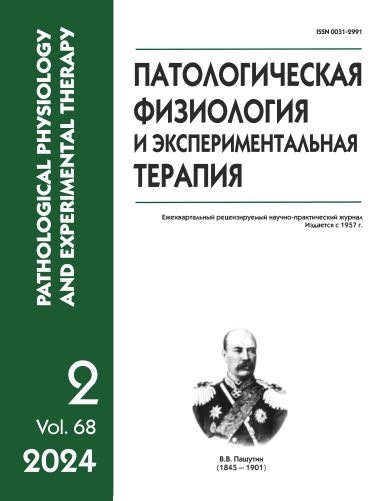Влияние полилактидных раневых покрытий с про- и антиоксидантными компонентами на тиоловый гомеостаз и активность супероксиддисмутазы и каталазы у крыс с послойным дефектом кожи
DOI:
https://doi.org/10.25557/0031-2991.2024.02.57-67Ключевые слова:
Раневые покрытия, послойный дефект кожи, таниновая кислота, перкарбонат натрия, антиоксиданты, полилактид.Аннотация
Введение. Свободнорадикальные процессы являются неотъемлемой частью заживления ран, с одной стороны оказывая альтерирующее действие на собственные ткани, и с другой являясь важными регуляторами репаративных процессов. Использование адресной доставки прооксидантов и антиоксидантов в лечении ран открывает новые перспективы для улучшения исходов регенерации. В этой связи целью настоящего исследования явилось изучение влияния микрокамерных полилактидных раневых покрытий, обеспечивающих адресную доставку про- и антиоксидантных компонентов, на состояние ферментативного и неферментативного звеньев антиоксидантной защиты у крыс с послойным эксцизионным дефектом кожи. Методика. Исследование проведено на 81 белой крысе, разделенных на пять групп: контрольную (n=9), сравненительную (n=18), три опытные (по n=18). У животных сравнительной и опытных групп оперативным путем создавалась модель кожной раны размером 10х10 мм. Животным опытной группы №1 дефект закрывался полилактидным микрокамерным раневым покрытием без активных компонентов. Крысам опытных групп №2 и 3 накладывалось аналогичное покрытие, микрокамеры которого были загружены таниновой кислотой и перкарбонатом натрия соответственно. Оценивались активность супероксиддисмутазы и каталазы, а так же концентрация тиоловых групп в сыворотке крови. Результаты и выводы. Повреждение кожи вызывает изменения ферментативного и неферментативного звеньев актиоксидантной защиты. Применение микрокамерного раневого покрытия, загруженного таниновой кислотой, препятствует снижению концентрации тиоловых групп и повышению активности супероксиддисмутазы и каталазы. Применение микрокамерного раневого покрытия с перкарбонатом натрия способствует снижению активности супероксиддисмутазы, восстановлению концентрации тиоловых групп в сыворотке крови на поздних этапах репаративного процесса, но при этом практически не оказывает влияние на активность каталазы. Таким образом, загрузка про- и антиоксидантных компонентов в микрокамерное полилактидное покрытие позволяет корректировать изменения тиолового статуса, активности супероксиддисмутазы и каталазы у крыс полнослойным дефектом кожи.Загрузки
Опубликован
2024-06-23
Выпуск
Раздел
Оригинальные исследования
Как цитировать
[1]
2024. Влияние полилактидных раневых покрытий с про- и антиоксидантными компонентами на тиоловый гомеостаз и активность супероксиддисмутазы и каталазы у крыс с послойным дефектом кожи. Патологическая физиология и экспериментальная терапия. 68, 2 (Jun. 2024), 57–67. DOI:https://doi.org/10.25557/0031-2991.2024.02.57-67.













